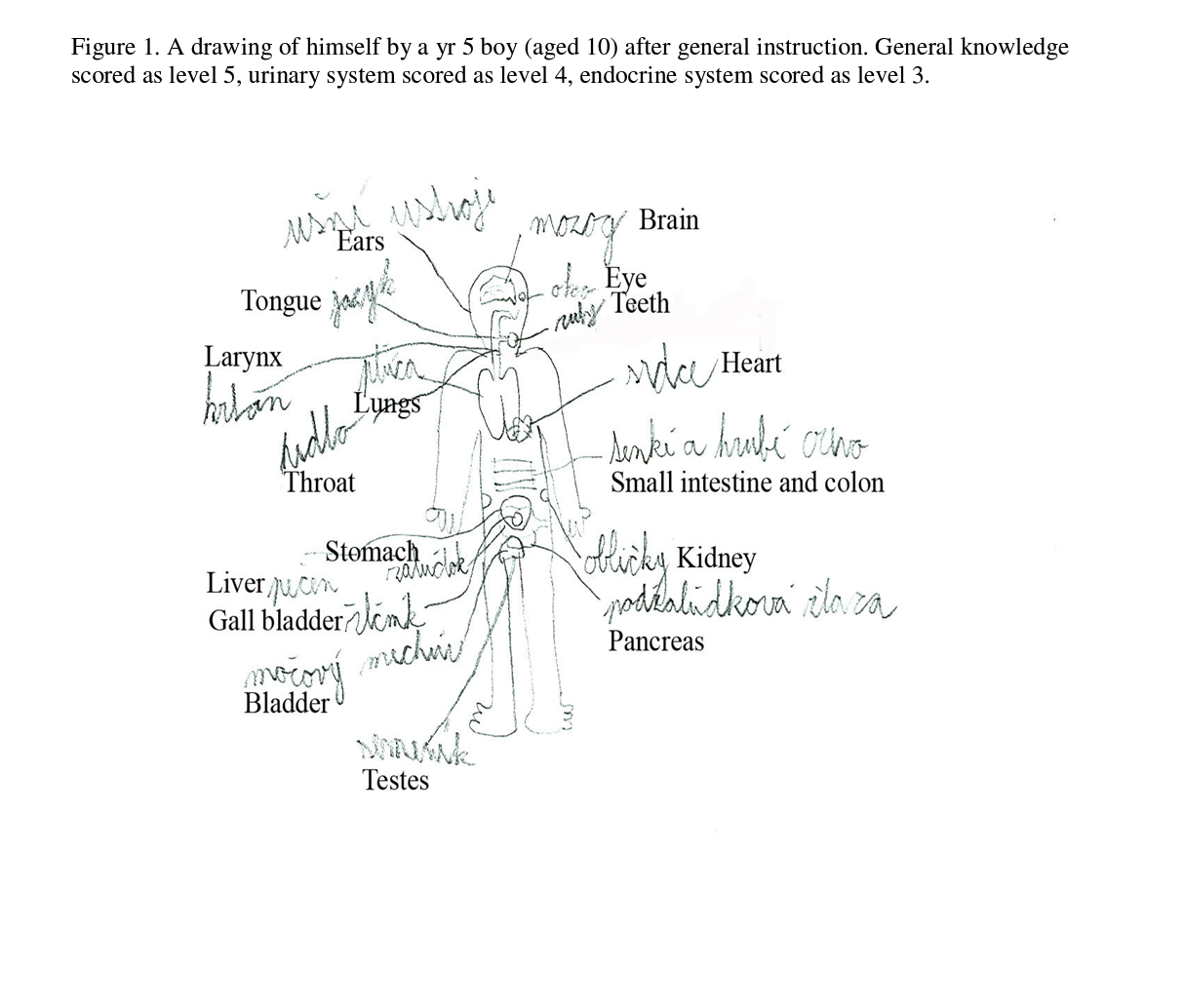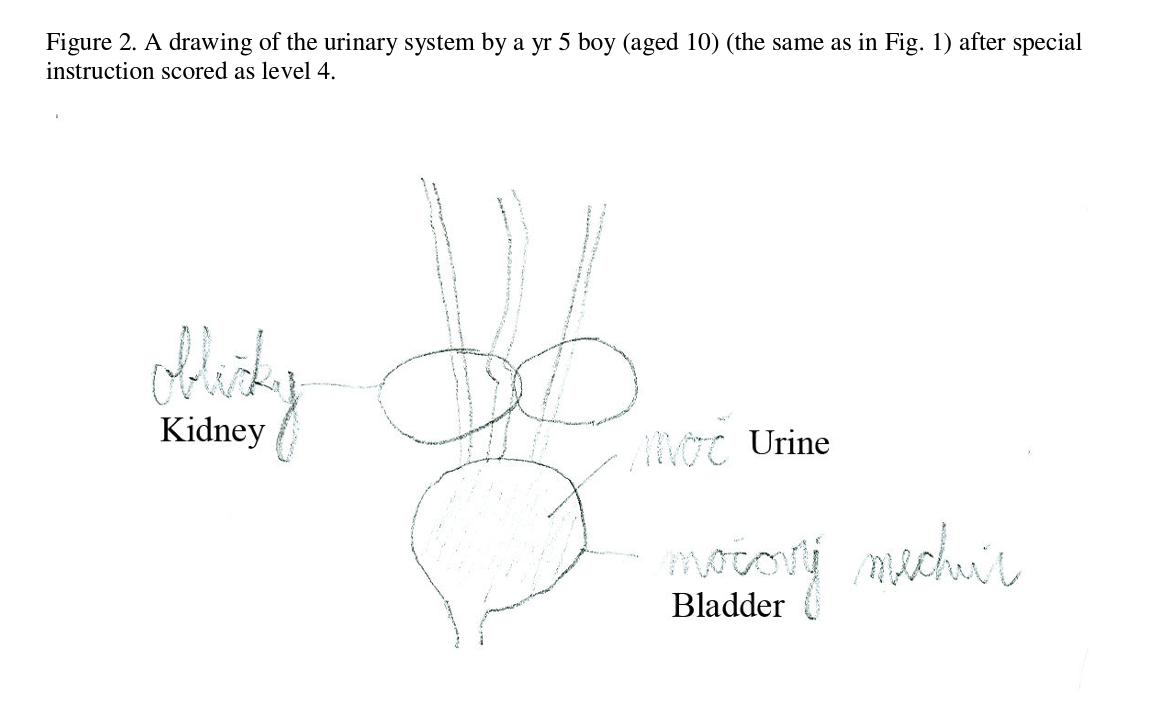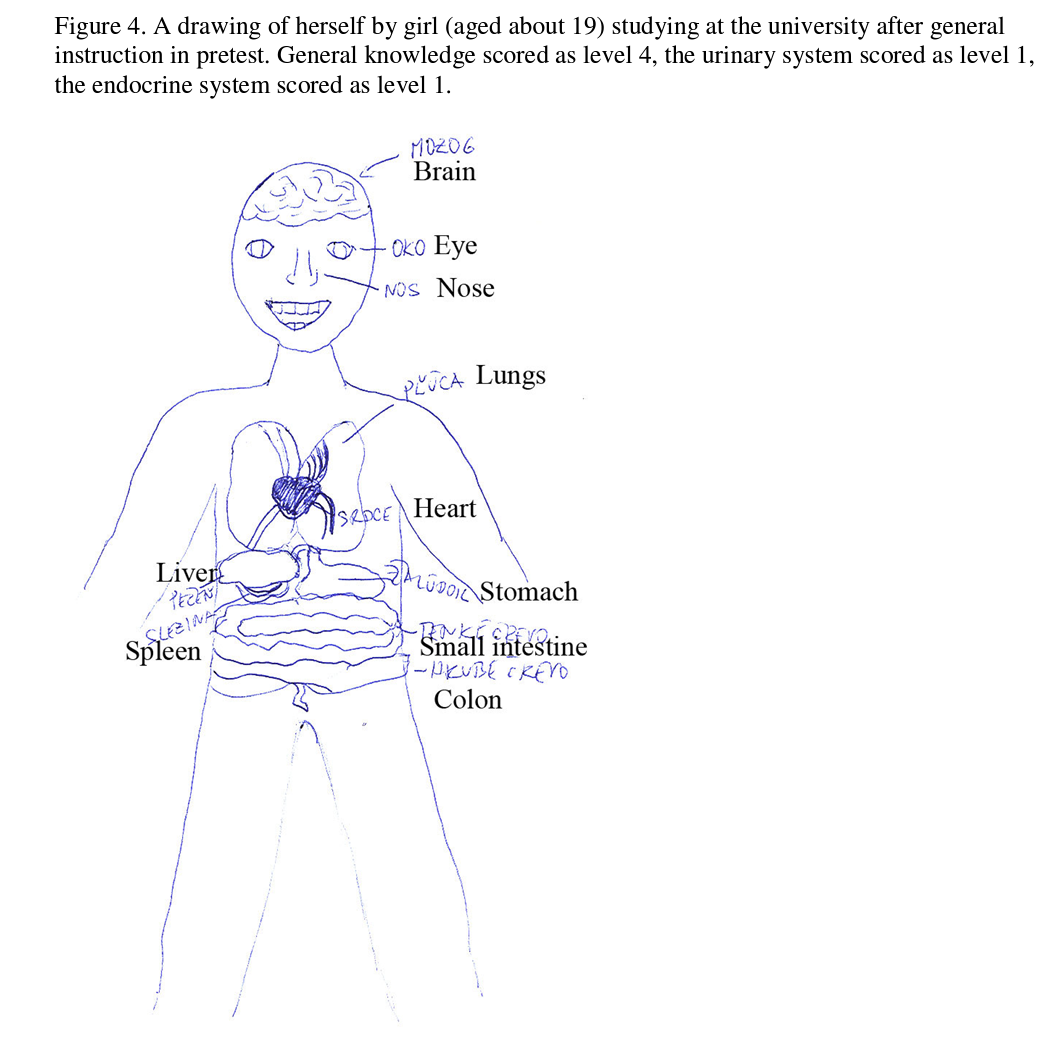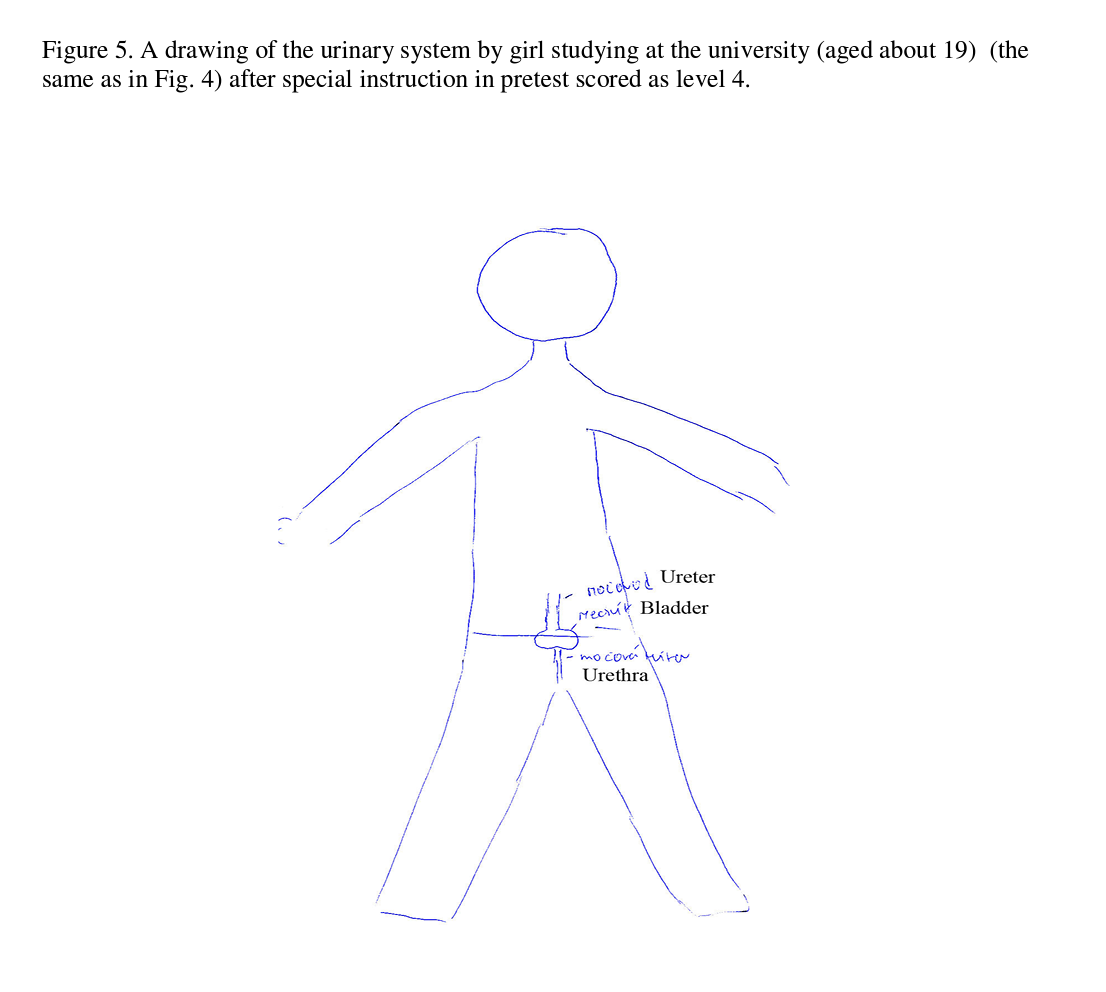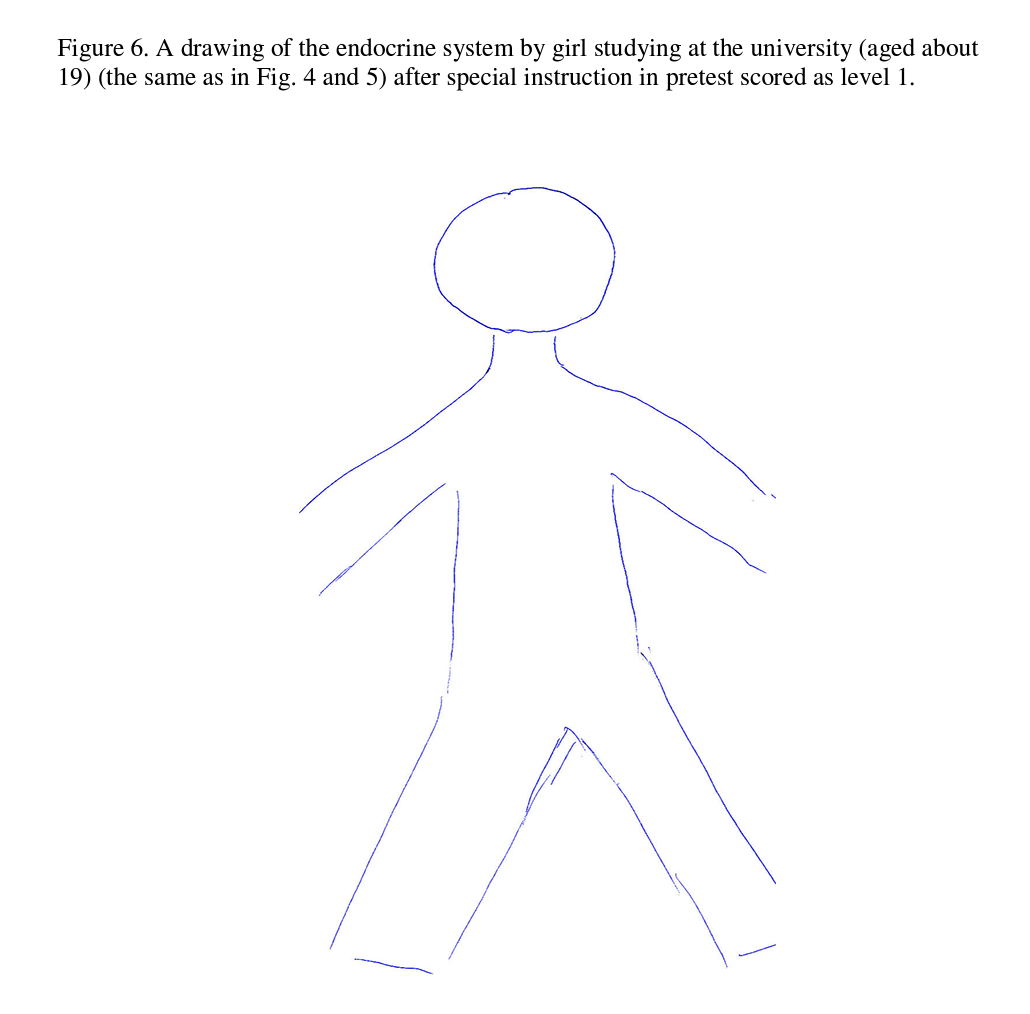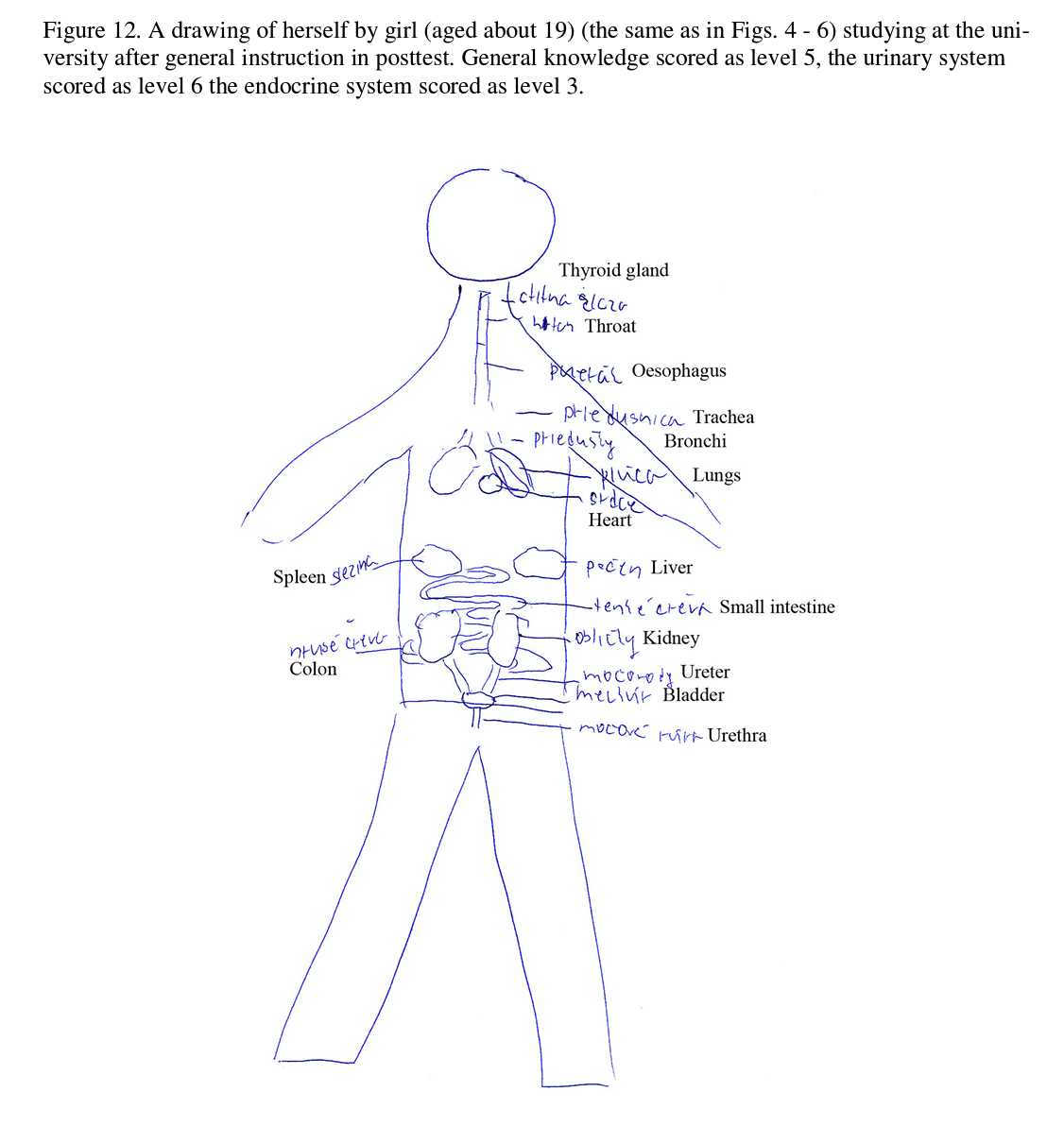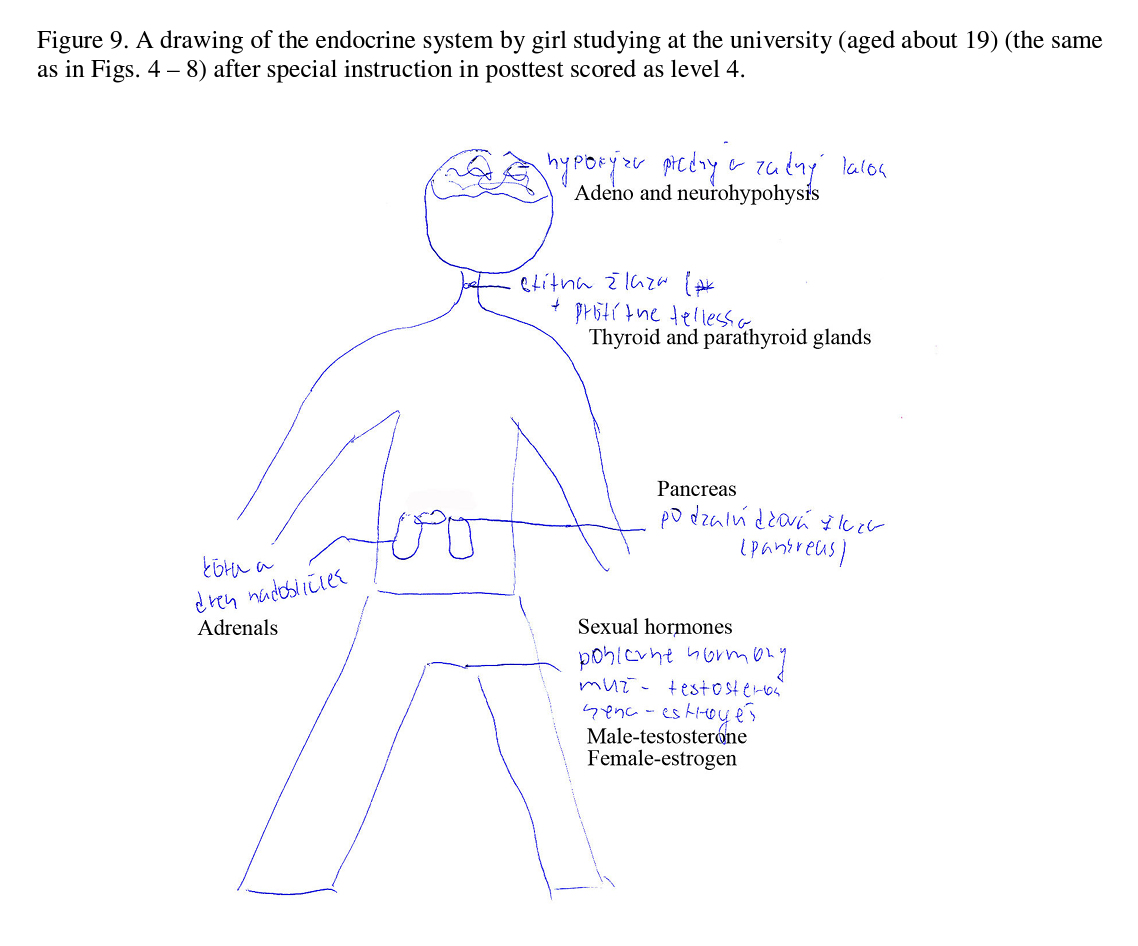The Effect of Type of Instruction on Expression of Children’s Knowledge: How Do Children See the Endocrine and Urinary System?


Published: Jan. 10, 2009
Latest article update: Dec. 30, 2022
Abstract
Children’s knowledge about human anatomy can be examined through several different ways. Making a drawing of the internal features of the human body has been frequently used in recent studies. However, there might be a serious difference in results obtained from a general instruction to students (What you think is inside your body) and specific (e.g. Draw bones that are inside your body) instruction. We examined relationships between these two types of instructions using drawings of the urinary and endocrine systems as the examples with pupils aged 10-14 years. An ANCOVA showed significant relationships between general and special instruction, but further comparison showed significant correlation only for urinary system. The level of students’ drawings significantly increases with previous knowledge about human anatomy and age. These findings suggest that relationships between two types of instructions strongly depend on the complexity of the organ system that children draw as well as their previous knowledge. We propose that drawings from general instructions are therefore appropriate especially for comparative studies. Special instructions are better for eliciting a deeper understanding of children knowledge about human anatomy.
Keywords
Understanding, instruction, human anatomy
Introduction
Students’ concepts of scientific phenomena, especially about human anatomy received great attention in earlier (Gellert 1962, Johnson and Wellman 1982, Mintzes 1984, Caravita and Tonucci 1987) and recent studies (Tunnicliffe and Reiss 1999, Teixeira 2000, Reiss and Tunnicliffe 2001, Reiss, Tunnicliffe et al. 2002). In agreement with several conventional ways for gathering information about students’ knowledge (White and Gunstone 1994), these studies also differ in using different methods to examine children’s mental models. Mental models may be viewed as representation of an object or an event. The process of constructing models is mental activity (Duit and Glynn 1996). The mental model can be therefore considered children’s personal knowledge of the phenomenon - in this case of the present paper, of human body, particularly of urinary and endocrine system.
In several investigations, Tunnicliffe and Reiss (1999a,b), Reiss and Tunnicliffe (1999, 2001), Reiss, Tunnicliffe et al. (2002) used the method of children drawing where they asked children “Draw what you think is inside your body”. Their approach has been criticised by Khwaja and Saxton (2001) who found out that the type of the task can significantly affect results obtained in these studies. They showed that if the question is more special (“Draw the bones that are inside your body”), children’s expression of mental model of a particular organ system is on a higher level and thus more appropriate in comparison with Reiss and Tunnicliffe’s (1999) “general instruction”. More specifically, when Khwaja and Saxton scored skeletal system from drawings obtained after “general instruction”, they found that mean level of skeletal system was lower than when they instructed the same participants more specially. For example, one child scored level 1 when instructed generally, but her score rose to level 5 when she was instructed specifically.
Despite such simple comparison of Khwaja and Saxton (2001) who partly highlighted apparent flaw in the methods used by Reiss and Tunnicliffe (1999) because they claimed that the type of instruction has main effect on the results obtained from children’ drawings, it is not clear if there are any relationships between drawings obtained by each of the two types of instructions. Do children with higher knowledge about the anatomy result in better drawings even after they are instructed “generally” following Reiss and Tunnicliffe (1999) or are these drawings of a lower scientific or educational value? Moreover, Khwaja and Saxton’s (2001) research was used to examine only the skeletal system. Reiss and Tunnicliffe (1999) examining children’s understanding of human skeleton showed that majority of children aged 5-11 reached level 5 on the seven point scale which means that their knowledge is still incomplete, but relative good. Reiss and Tunnicliffe (2001) in their following study using “general instruction” showed that there are considerable differences between knowledge about each organ systems. They also found that the skeletal system is one of the most frequently drawn systems in comparison with others. Therefore, it is not known whether children draw more comprehensive organ systems after “special instruction” in general, or their abilities are restricted to organ systems they better understand. In other words, no evidence exists whether more frequently drawn organ systems are also better understood by children.
In the present study, we used the instructions according to both Reiss and Tunnicliffe (1999) and Khwaja and Saxton (2001). We examined whether these two types of instructions have comparable value. We addressed the following research question: Is there any relationship between levels of drawings of a particular organ system when the children are instructed by two different instructional types? If yes, we predicted that the level of a particular organ system should increase with increasing knowledge about human anatomy regardless of the type of instruction. On the contrary, when the level of a particular system obtained from special instruction does not correspond with the level from “general drawings”, one would expect that after increasing knowledge about human anatomy the level of particular system will increase only after special instruction, but its level after general instruction remains unaffected.
Methods
We investigated the effect of instruction type through two different ways. First, two hundred and eighty nine secondary school children (aged 10-15) with similar proportion of boys and girls from two different Slovak elementary schools participated in the study. Children in Slovakia begin elementary school at 6 years (year 1 children) and left the school when they
are about 14 - 15 (year 9 children). Reiss and Tunnicliffe (2001) used children and students of wider age groups (from 4 to 20 years old), Reiss and Tunnicliffe (1999) worked with children from 5 to 11 years whereas Khwaja and Saxton (2001) worked with only 10 year old children to investigate children’s concept about human anatomy. Our sample can be therefore considered appropriate for a comparative study. The effect of type of instruction type was examined on a single occasion when each child received two sheets of paper and subsequently was asked first “Draw what you think is inside your body” (general instruction hereafter “GI”) according to Reiss and Tunnicliffe (1999) method. After 10 minutes, when the children finished their first drawing, we used the special instruction (“Draw the urinary system that is inside your body”, hereafter “SI”) according Khwaja and Saxton (2001) to examine if there are differences between the type of instruction. When this second drawing on a separate sheet was finished, we asked children to draw endocrine system following SI (i.e. “Draw the endocrine system that is inside your body”) on an opaque side of the paper. This second system was used to examine whether there are similar trends between children’ knowledge even after special instruction. The study of Reiss and Tunnicliffe (2001) showed that endocrine organs and/or organ system are one of the least frequent while urinogenital system is more frequent in children’ drawings, but, however, their knowledge still remains incomplete (Tunnicliffe 2004). We therefore considered these two systems and/or organs of these systems as qualitatively different in context of children knowledge.
Children were asked to write their name on each of two papers in order to determine identity of each respondent for pair wise comparisons. We scored drawings “Draw what you think is inside your body” (GI) following Reiss, Tunnicliffe et al. (2002) to examine general knowledge about human anatomy (Table 1, Fig. 1 in Appendix A). Then the two of us separately and independently scored specially urinary and endocrine systems. In the few cases where our scorings differed we discussed the drawing until we agreed on the level to be awarded. Our ranking of these two systems was informed by scoring system used by Reiss and Tunnicliffe (2001) and by our own knowledge of anatomy and Slovak biology curricula. We agreed on the order showed in Table 2 and 3. We examine level of these two systems both from drawings after general (GI, Fig. 1 in Appendix A) and special instruction (SI, Figs. 2 and 3 in Appendix A).
Second, the effect of increasing knowledge about human anatomy on the level of organ systems and, as in the previous case, urinary and endocrine system was examined using pretest -posttest procedure with the university students. A sample consisted of a total of 52 year 1 students (aged 19-20) who have been studying to become primary teachers. All of them were girls. They were learning subject Human anatomy teaching by one of investigators for two semesters from October 2004 to May 2005.
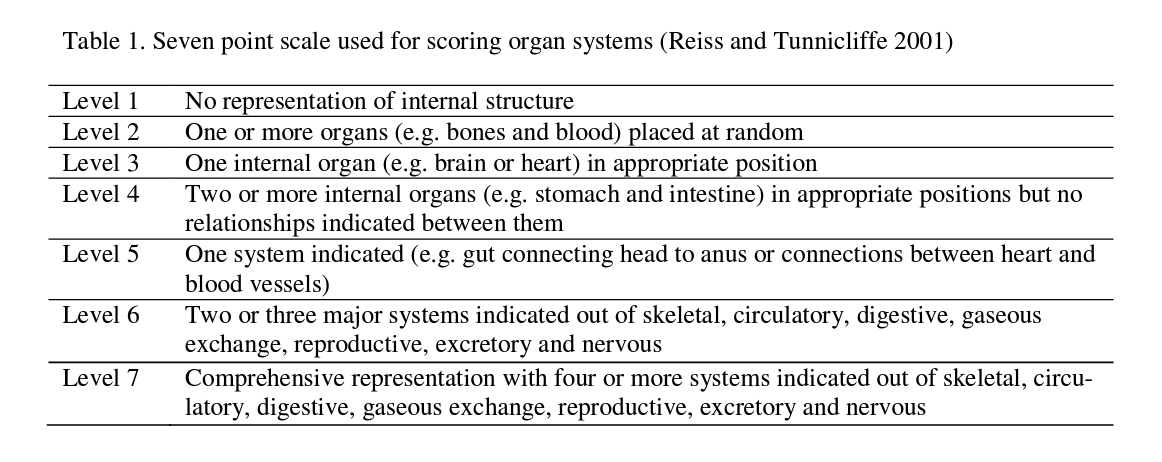
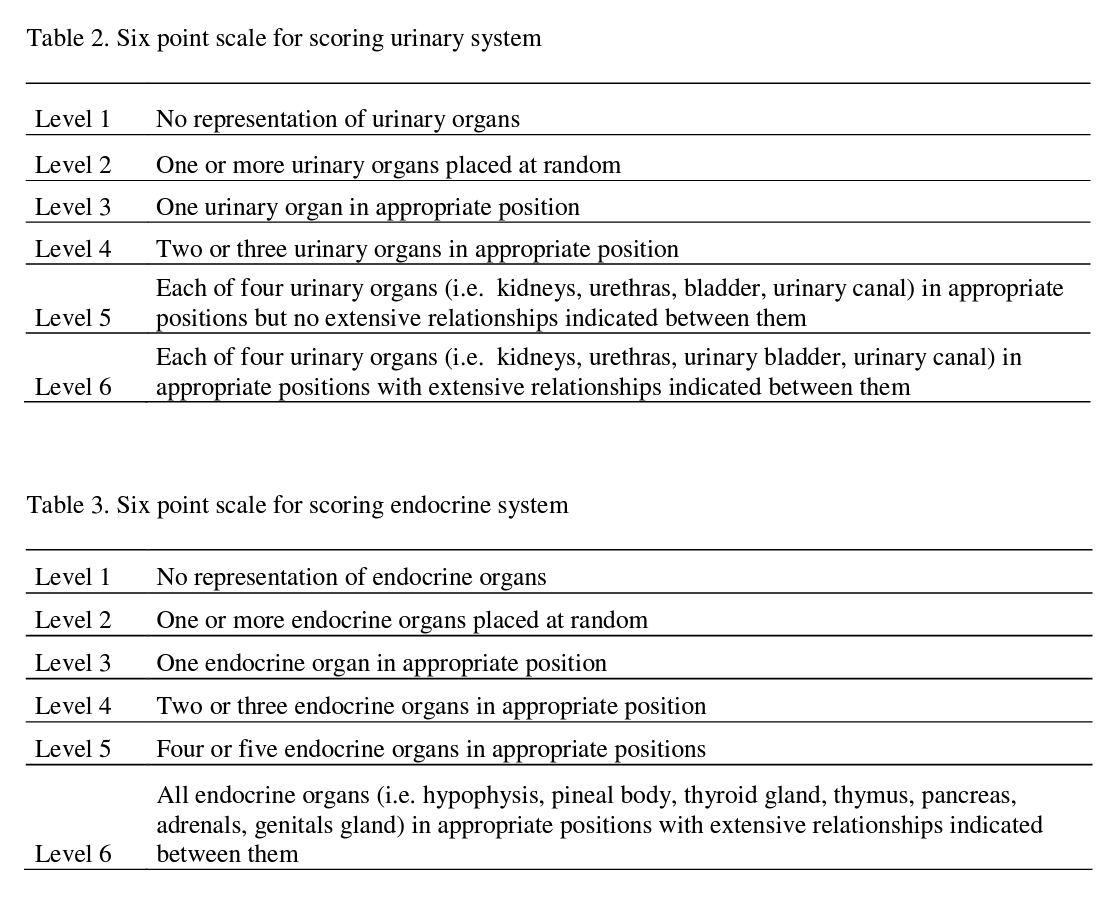
The curriculum for the subject includes topics from cell biology to human organ systems. Each student was asked to draw human body and both endocrine and urinary system similarly as in the case of elementary school children (i.e. both GI, Figs. 4, 7 and SI, Figs. 5, 6, 8, 9 in Appendix A) two times: before first lecture of Human anatomy in October (Figs. 4- 6 in Appendix A) and prior to examination in May (Figs. 7-9 in Appendix A). Drawings were anonymous, but students were instructed to make an individual symbol on each sheet of paper for future pair wise comparisons. However, several students were not present when pretest or posttest took place, or some of them forgot to make the symbol. We therefore excluded 23 students of which drawings were incomplete. A total of 29 students were then included to the final analyses. Scoring system was the same as in the previous case.
Results
General knowledge about human anatomy
We identified a total of 42 different organs in all of 289 drawings obtained from five different year groups of children (aged 10 - 15). Table 4 shows eight of the most preferred organs which were drawn in at least 30 percent of all drawings. Gender differences occurred in the only two cases whereby the heart and brain was most frequently in girls’ drawings.
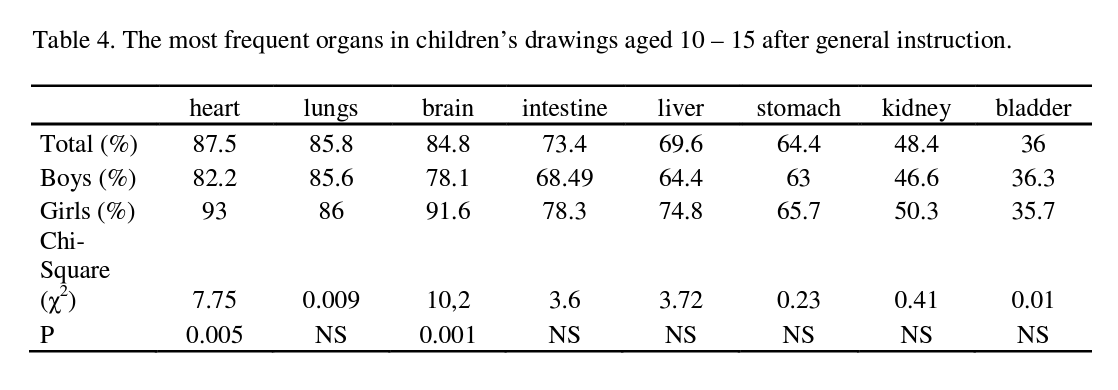
However, we found gender differences in sex-specific organs, i.e. in a reproductive system. No one boy, but 26 girls (18%) drew uterus (/ -29.2, P<0.001) and only two boys, but 16 girls showed ovaries in their drawings (/2=11.9, P<0.001). In contrast, testes were preferentially drawn by boys (16 boys vs 1 girl, /2=13.7, P <0.001). Interestingly, penis was present in drawings of boys (n-14) and girls (n-7) almost equally (P-0.12).
As suggested, organs from urinary system were present among the most frequent organs (Table 4), but endocrine organs received only little attention. From the most conservative point of view, only 20 drawings (7%) showed parts of endocrine system (adrenals, thyroid gland, hypophyses) which is comparable with results of Reiss and Tunnicliffe (2001) who reported that about 4% of drawings showed endocrine organs. After including pancreas, that is properly deemed to belong to the digestive system (Reiss and Tunnicliffe 2001), and ovaries with testes (scored by us and Reiss and Tunnicliffe as reproductive organs), sample size with endocrine organs increased to 71 drawings (24.6%).
The two-way ANOVA showed that the mean scores from drawings did significantly differ between year groups (F4>279=3.91, P-0.004), but the effect of gender nor interaction between year and gender was no significant. As could be expected, higher scores were obtained from drawings of older children and least scores from younger children (Fig. 10).
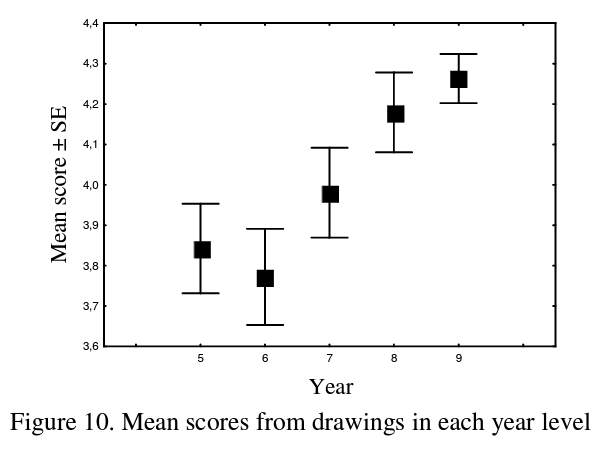
Differences between general and special instruction
Drawing scores obtained after General and Special Instructions for urinary and endocrine system are shown in Fig. 11 and 12. Highest scores for each two systems were obtained
mostly by year 7 and 9 children. This corresponds with Slovak biology curriculum, because subject Human anatomy is teaching in year 7 children, and also in part in year 9 children.
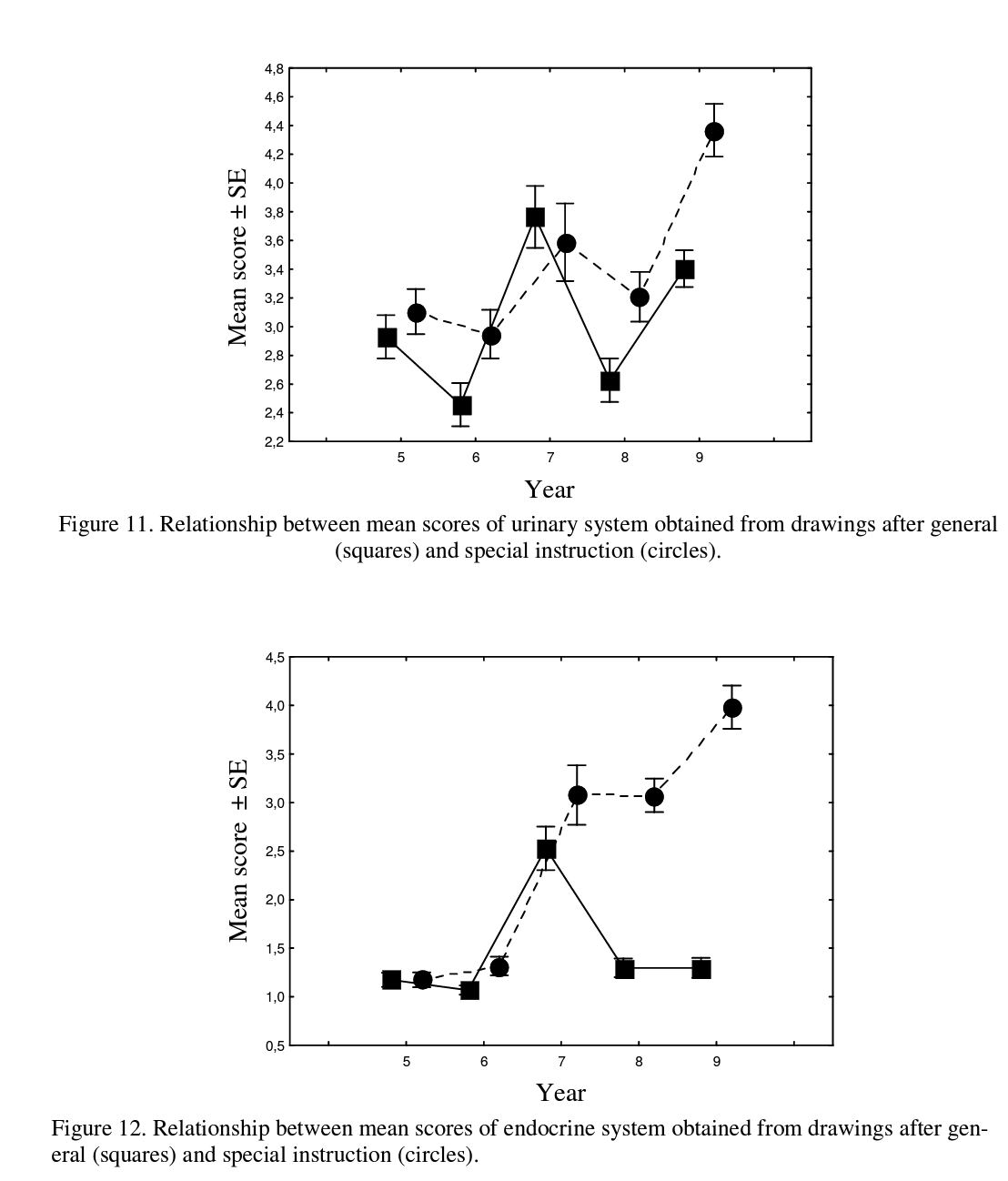
We also examined whether drawings of a particular system (i.e. from SI) can be explained by drawings obtained from GI. We therefore used an analysis of covariance (AN- COVA) with scores from SI as a dependent variable, year of children as factor and score from GI as covariate. We found that both the urinary and the endocrine system scores were influenced, not only by the year of children (P<0.001 for both variables), but the level of SI drawings can be significantly predicted from their level in GI drawings (P<0.01 for both variables). Further comparisons using Pearson correlation coefficient showed, however, there are considerable differences between predictability of drawings between these two organ systems. Significant correlation was found between scores from GI and SI only for urinary system (r-0.22, p<0.001, n-289), but not for endocrine (r=-0.007, p-0.91, n-289).
The effect of increased knowledge about anatomy on students’ drawings
A comparison of university students’ drawings obtained from pretest - posttest procedure (n-29) showed that general knowledge about human anatomy significantly increased in the posttest drawings (Fig. 14). Moreover, the score level for both urinary and endocrine system was higher in posttest drawings regardless of the type of instruction. This means that students with better knowledge draw better drawings from which their knowledge about particular organ system (at least urinary and endocrine) can be relative well predicted. Also, similarly as in the previous case, the endocrine system acquired a lower mean score than did the urinary system.
Discussion
Our study illustrates how information can be obtained from purposeful drawings and has advantages for example due to time saving or simplicity of scoring over oral questioning or writing tasks. We used both general (Draw what you think is inside your body) and special tasks (Draw endocrine and urinary systems that are inside your body).
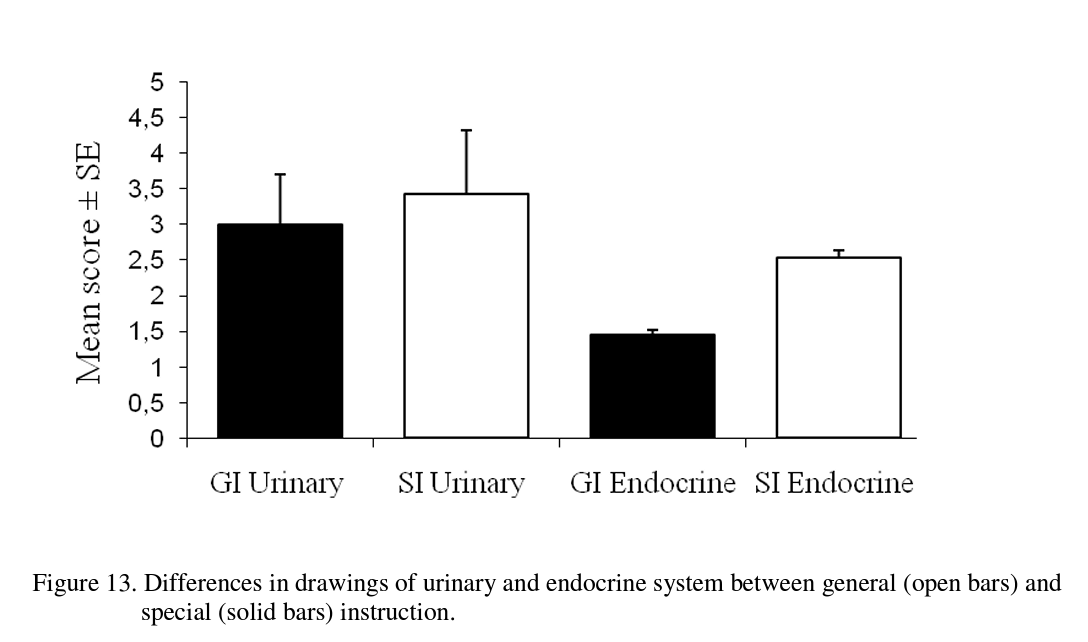
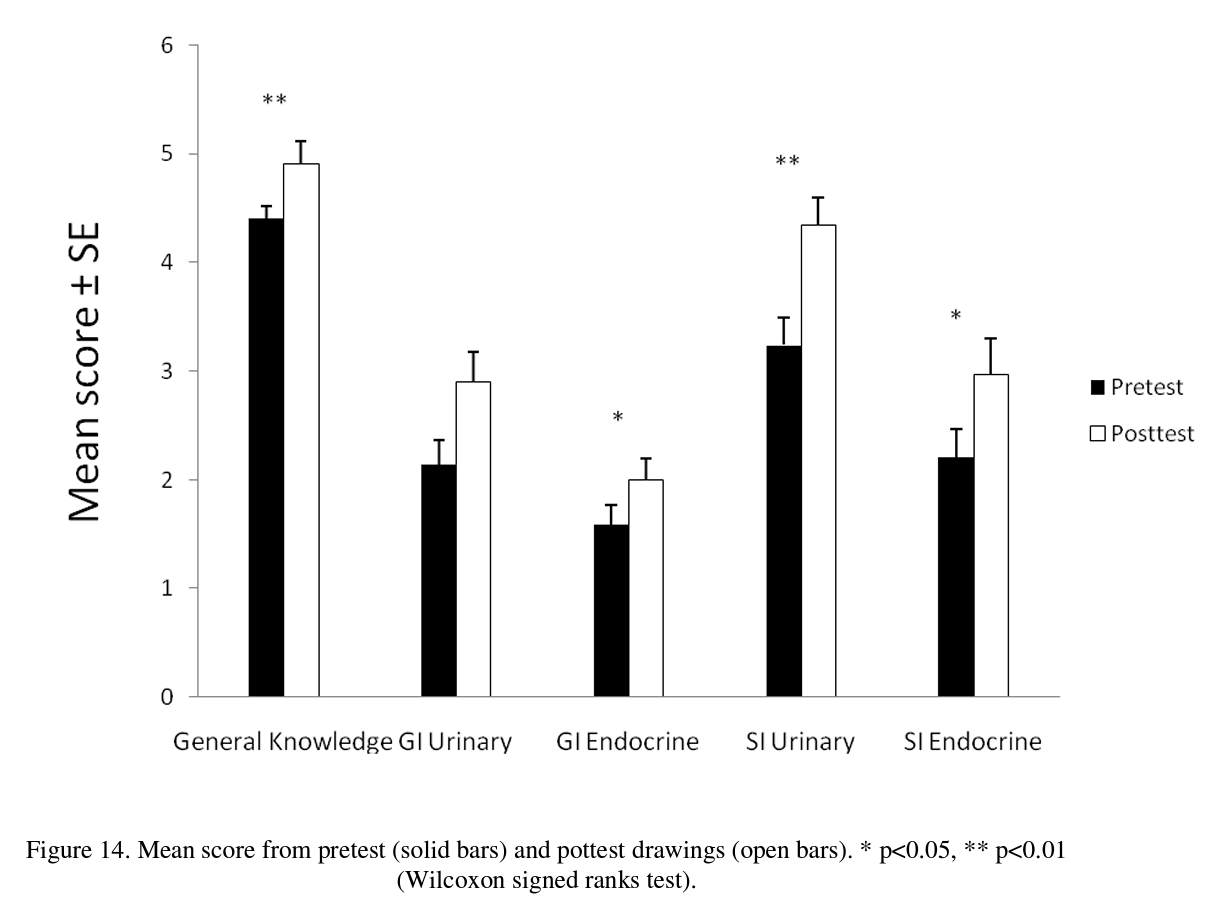
On the other hand, some children lack manual dexterity skills or the mental agility to produce a correct record of their mental model. The drawing is the expressed model which may or may not coincide with the consensual model held by scientists (Backett - Milburn and McKie 1999).
Two important findings related to the type of instruction emerged from the present study. First, a significant relationship between “general” and “special” instruction exist, and, second, the drawing of the human body is affected by children’s current knowledge about human anatomy.
The first finding should be, however, interpreted cautiously, because there are different patterns for both urinary and endocrine system. The endocrine system is probably viewed as more difficult and abstract in comparison with the urinary system. Thus we did not find correlation between drawings from a “general” and “special instruction” method for this system and why the scores for the endocrine system were generally lower in comparison with the urinary system. These patterns partly support idea that children draw mainly these organs that are also better to understand.
One would argue that increasing level of both examined systems in “general drawings” of the university students might be influenced by students’ previous experiences, because they completed drawings two times: prior and after finishing course of Human anatomy. However, 1. the time between the first and the second drawing was a long enough (8 months) and majority of students did not remember what they drew in their first drawings, and 2. both the urinary and endocrine systems were better drawn after special instruction regardless whether drawings were completed in October or May. So, if the students had been cued from their previous drawing, their level of drawings after special instruction should not differ in comparison with general instruction in the posttest (i.e. in May) drawings. Based on our data, however, we can clearly reject this possibility. In the case of elementary school children, they first completed GI drawings and SI drawings were completed immediately after (following Khwaja and Saxton 2001) under the same conditions. Therefore, effect of previous cues on the subsequent or previous drawing could be ruled out.
In agreement with the findings of Khwaja and Saxton (2001), we found that the children made better drawings of a particular organ system after “special instruction”. We therefore agree that if the researcher/teacher wants to accurately assess the full extent of children knowledge, this type of instruction is more appropriate than general tasks that do not concentrate children attention to the particular phenomenon. A similar approach related to the urinary and digestive system was used by Tunnicliffe (2004) who instructed children using short stories scenarios that finished as for example “draw the pathway through your body of the water you drink.”
On the contrary, at least a simple urinary system is similarly drawn after each of two types of instructions which mean that there is a significant predictability of eliciting children’s own knowledge from drawings made under “general” instruction. From this point of view using data from drawings of the urinary system for comparison between several year groups, gender, or other variables, should provide reliable results. We therefore conclude that drawings originated after general instructions (Reiss and Tunnicliffe 1999 and others) may have a representative value especially in comparative studies. However, what patterns are related on other organ systems expressed in children’s drawings remains unclear and we address this question for further research.
Educational implications
Teachers need to be aware of the knowledge about a topic; in this case the urinary and the endocrine systems before they initiate a teaching programme about the topic so that they are aware of the understanding processed by their pupils and can help them scaffold the concepts. The urinary system is for most children some thing which in part they experience first hand and often through their own excretory processes whereas the endocrine system can be concealed until puberty.
With an increase in health education programmes it is essential that teachers learn more about the knowledge of the body and how its workings if we are effectively to assist these pupils take responsibility for their own health and lead a healthy life style.
References
- Backett - Milbum К and McKie L (1999) A critical appraisal of the draw and write technique. Health Education Research, 14, 387 - 398.
- Caravita S and Tonucci F (1987) How children know biological structure - function relationships. Paper presented at the Second International Seminar: Misconceptions and Educational Strategies in Science and Mathematics, 26 - 29 July (Ithaca, NY: Cornell University).
- Duit R and Glynn S (1996) Mental modelling. In: Research in Science Education in Europe, ed. Wel- ford, G., Osborne, L, Scott, P. London: Falmer.
- Gellert E (1962) Children’s conceptions on the content and functions of the human body. Genetic Psychology Monograps, 65, 293 - 405.
- Johnson C N and Wellman H M (1982) Children’s developing conceptions of the mind and brain. Child Development, 53, 222 - 234.
- Khwaja, С C and Saxton J (2001) It all depends on the question you ask. Primary Science Review, 68, 13 -14.
- Mintzes J J (1984) Naive theories in biology: Children’s conceptions of the human body. School Science and Mathematics, 84: 548 - 555.
- Reiss M J and Tunnicliffe S D (1999) Children’s knowledge of the human skeleton. Primary Science Review, 60,7 - 10.
- Reiss M J and Tunnicliffe S D (2001) Students’ understandings of human organs and organ systems. Research in Science Education, 31, 383 - 399.
- Reiss M J, Tunnicliffe S D, Andersen A M, Bartoszeck A, Carvalho G S, Chen S Y, Jarman R, Jonsson S, Manokore V, Marchenko N, Mulemwa J, Novikova T, Otuka J, Teppa S, Rooy W V (2002) An international study of young peoples’ drawings of what is inside themselves. Journal of Biological Education, 36, 58 - 64.
- Teixeira F M (2000) What happens to the food we eat? Children’s conceptions of the structure and function of the digestive system. International Journal of Science Education, 22, 507 - 520.
- Tunnicliffe S D (2004) Where does the drink go? Primary Science Review, 85, 8 - 10.
- Tunnicliffe S D and Reiss M J (1999a) Students’ understanding about animal skeletons. International Journal of Science Education, 21, 1187 - 1200.
- Tunnicliffe S D and Reiss M J (1999b) Learning about skeletons and other organ systems of vertebrate animals. Science Education International, 10, 29 - 33.
- White R T and Gunstone R F (1994) Probing understanding. London: Fahner Press.
Appendix: Examples of participants’ drawings
